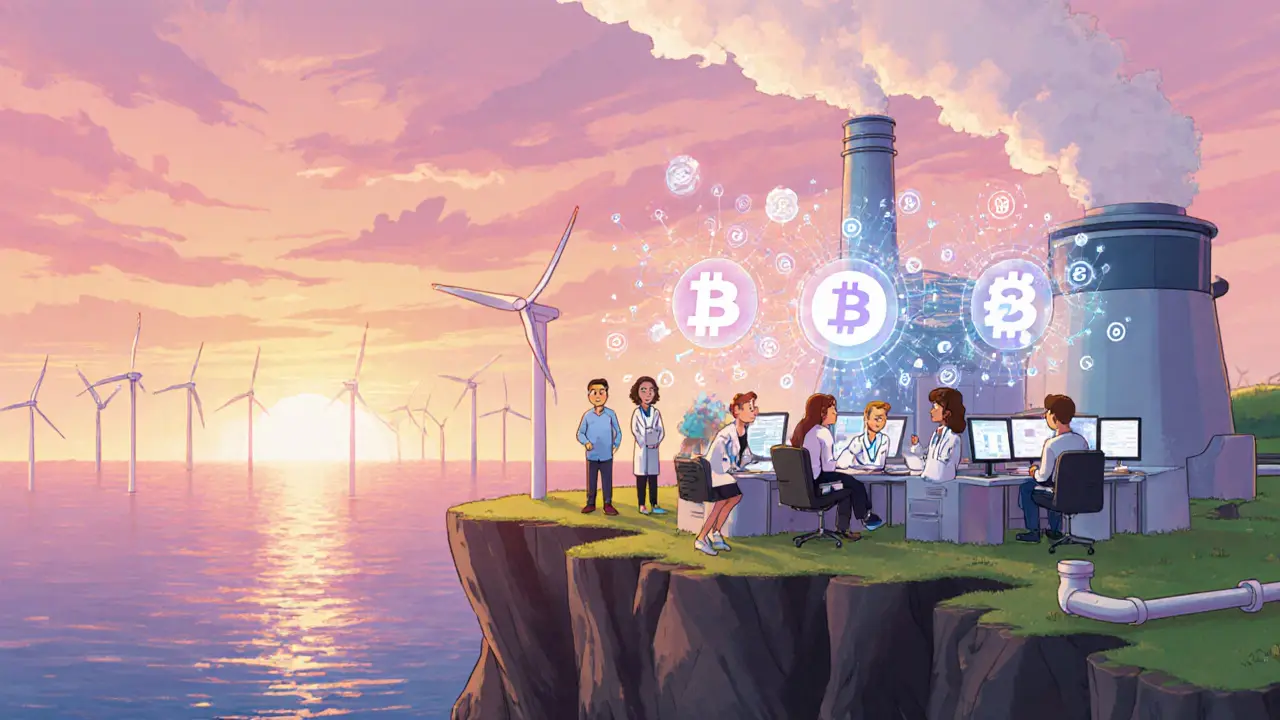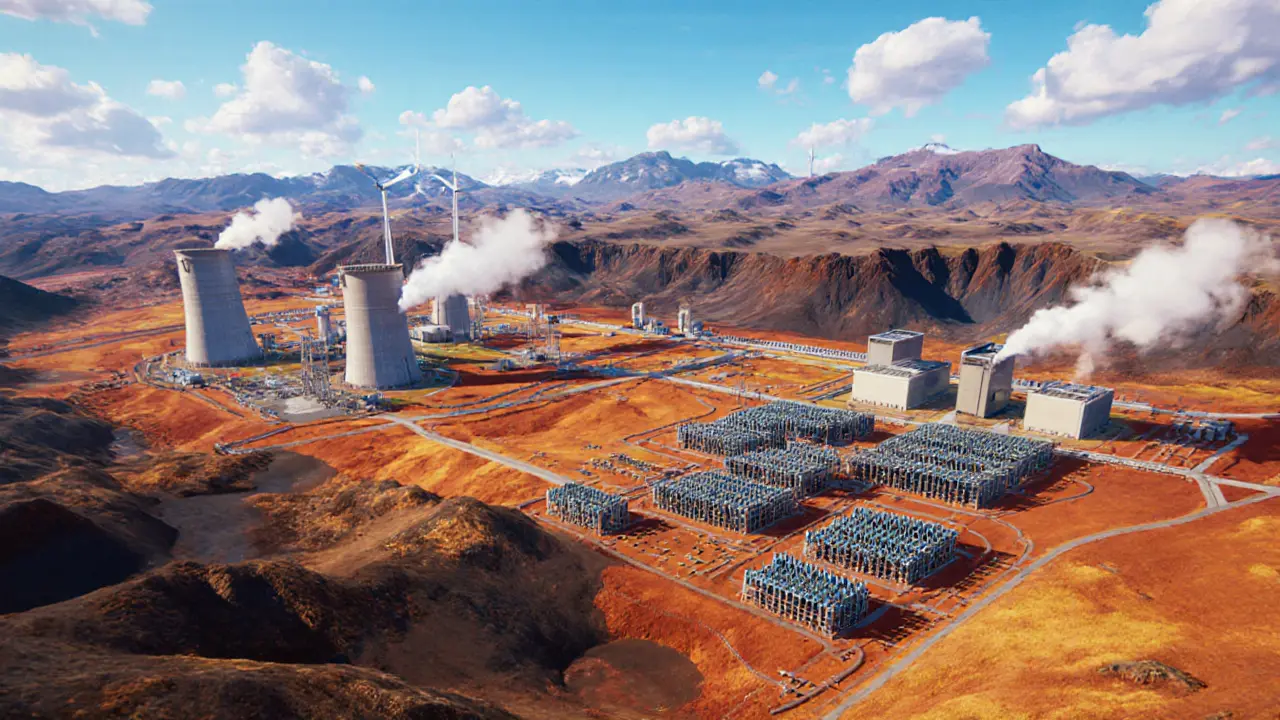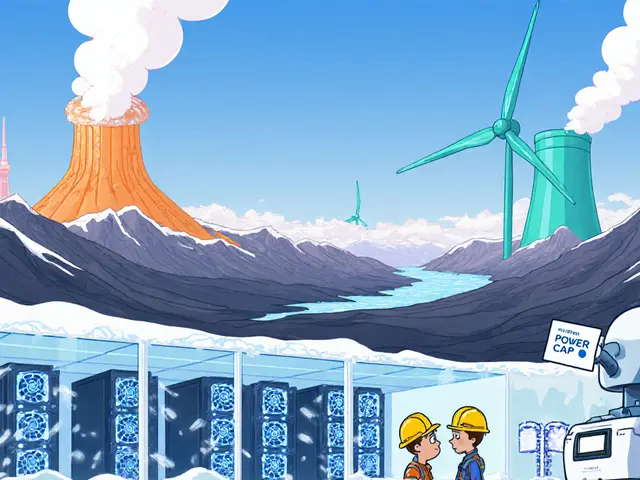Iceland Mining Electricity Cost Calculator
Calculate how Iceland's time-of-use pricing affects your mining operations
Results will appear here after calculation
When you hear Iceland cryptocurrency mining restrictions the set of rules and power‑allocation limits that affect crypto‑mining farms in Iceland, the first thing that comes to mind is the country’s cheap, renewable electricity and near‑free cooling. But the story has turned into a tug‑of‑war between miners chasing low costs and a national power company trying to protect the grid.
Key Takeaways
- Iceland’s abundant geothermal and hydro power made it a mining hotspot, but consumption now rivals the country’s total residential demand.
- Landsvirkjun, the state‑owned power utility, has introduced caps, demand‑response programs, and higher tariffs for high‑intensity mining.
- Regulatory pressure comes from both the government and the Icelandic Financial Supervisory Authority, which monitors AML compliance.
- Major operators - Hive Blockchain, Genesis Mining, and Bitfury - are either scaling back or moving to hybrid renewable‑grid contracts.
- Future policy may steer the sector toward blockchain services and CBDC research rather than raw mining.
Why Iceland Became a Mining Magnet
Iceland an island nation in the North Atlantic with over 80% renewable electricity generation offered two unbeatable advantages for miners:
- Geothermal and hydro power kept electricity prices among the lowest in Europe - roughly $0.04/kWh in 2024.
- Average winter temperatures hover around -2°C, allowing servers to stay cool without expensive air‑conditioning.
By 2017, crypto‑processing accounted for about 90% of the island’s data‑center power use. In 2023, mining equipment was draining more electricity than the entire Icelandic population combined, a fact that alarmed both policymakers and the public.

The Role of Landsvirkjun
Landsvirkjun Iceland’s national electricity generator, owning 75% of the country’s power plants is the entity behind the recent restrictions. While the utility never published a dedicated “crypto‑mining policy,” it rolled out three practical measures in 2024 and 2025:
- Capacity caps - New mining projects must prove they won’t exceed a 5% share of the regional grid’s peak load.
- Time‑of‑use pricing - Heavy users pay a premium during peak hours (6am-10pm), encouraging operations to shift to off‑peak periods.
- Demand‑response contracts - Large farms agree to curtail output on short notice in exchange for lower base rates.
These steps are designed to keep enough power for households, industry, and Iceland’s growing electric‑vehicle fleet.
Regulatory Landscape Beyond the Power Company
The Icelandic government has not enacted a separate crypto law, but existing frameworks affect mining:
- The Icelandic Financial Supervisory Authority the regulator overseeing financial service providers, including crypto exchanges enforces AML/KYC rules on any entity that offers trading services.
- Environmental impact assessments are required for any new data‑center larger than 10MW, meaning miners must submit detailed plans on cooling, emissions, and land use.
- In March 2024, the Prime Minister publicly called for a reduction in mining’s share of national power, prompting the utility’s recent measures.
All of these pieces work together to limit mining growth, even though there is no explicit ban.
Energy Sources: Geothermal vs. Hydro
Geothermal energy heat extracted from the Earth’s interior, providing stable baseload power supplies roughly 65% of Iceland’s electricity, while hydro makes up most of the rest. The renewable mix is a selling point for eco‑conscious miners, but the sheer load still stresses the grid.
Because geothermal plants cannot quickly ramp output up or down, Landsvirkjun relies on hydro reservoirs for flexibility. This limitation is why demand‑response contracts often target hydro‑linked facilities - they can shed load without jeopardizing baseload stability.

Major Players and Their Adjustments
Three big names dominate the scene:
| Company | Estimated Power Use (MW) | Recent Change |
|---|---|---|
| Hive Blockchain Technologies | 120 | Signed a demand‑response contract, cutting peak‑hour consumption by 30% |
| Genesis Mining | 95 | Moved 40% of hash rate to a new facility with higher off‑peak pricing |
| Bitfury Holding | 80 | Invested in on‑site geothermal cooling, reducing overall energy draw by ~10% |
These adjustments show that operators are willing to adapt, but the overall trend is a slowdown in new capacity adds.
Impact on the Local Economy
Mining once contributed roughly 2% to Iceland’s GDP and created high‑skill jobs in engineering and data‑center management. However, the sector’s volatility - especially when Bitcoin prices dip - means the government is cautious about over‑reliance.
Local sentiment is mixed. Many residents appreciate the foreign investment, but a 2024 survey found 57% worried about power outages during winter peaks. The government is therefore balancing economic benefits against the need to keep the grid reliable for households and tourism‑related businesses.

Where Iceland Might Go Next
Policy makers are signaling a shift from raw mining to broader blockchain services:
- Research into central bank digital currencies (CBDCs) is gaining traction, with the Central Bank of Iceland evaluating use‑cases for payments and financial inclusion.
- Funding programs for blockchain‑based supply‑chain tracking and renewable‑energy certification are being explored.
- Some mining firms are repurposing hardware for AI inference workloads, which can coexist better with the power‑grid constraints.
In short, the island may stay a tech hub, just not solely a Bitcoin‑hashing powerhouse.
Quick Checklist for Mining Companies Eyeing Iceland
- Confirm you can stay under the 5% regional peak‑load cap.
- Model your electricity bill using time‑of‑use rates - off‑peak operation can save 20‑30%.
- Prepare an environmental impact assessment that highlights geothermal cooling.
- Include mitigation plans for hydro‑based demand response.
- Engage with the Icelandic Financial Supervisory Authority early to ensure AML compliance.
- Consider a hybrid strategy: split hash power between Iceland and another low‑cost jurisdiction.
Frequently Asked Questions
What specific limits has Landsvirkjun placed on crypto mining?
The utility enforces a 5% cap on any new mining project's share of the regional grid’s peak load, applies higher tariffs during daytime peaks, and requires large farms to sign demand‑response contracts that allow instantaneous load shedding.
Are there any taxes specifically for mining in Iceland?
No dedicated mining tax exists. Operators pay the standard electricity rates that now include the time‑of‑use surcharge and any penalties for exceeding the capacity cap.
Can foreign companies own mining farms in Iceland?
Yes. Ownership is open to foreign investors, but they must register a local legal entity, comply with AML/KYC rules, and obtain the necessary environmental permits.
How does the demand‑response program work in practice?
When the grid reaches a predefined load threshold, Landsvirkjun sends a short‑notice signal (often via API) to participating farms. They must reduce their hash rate or shut down a portion of rigs within minutes, earning a discount on their base electricity price.
Is it still profitable to mine Bitcoin in Iceland?
Profitability depends on Bitcoin’s price, hardware efficiency, and the operator’s ability to run mostly off‑peak. With the new tariffs, miners who can shift 70% of work to night hours still see margins comparable to other low‑cost regions.
All things considered, the landscape is shifting. Iceland crypto mining restrictions are less about banning the activity and more about fitting it into a sustainable, grid‑friendly model. If you can adapt, the island still offers one of the world’s most attractive renewable‑energy environments for blockchain‑related ventures.


Comments
The restrictions imposed by the national power company in Iceland are a game changer for crypto miners worldwide.
First, the time‑of‑use pricing model forces operators to think like utility planners instead of just miners.
Second, by capping peak‑hour consumption, the company effectively throttles hash‑rate spikes that could destabilize the grid.
Third, the mandatory reporting framework gives regulators unprecedented visibility into who is drawing power and when.
Fourth, the steep penalties for non‑compliance mean that reckless mining rigs will either adapt or shut down.
Fifth, smaller, renewable‑powered farms stand to benefit because they can schedule operations during off‑peak windows and sell surplus energy back to the grid.
Sixth, the model mirrors the European Union’s approach to energy‑intensive industries, suggesting a broader regulatory wave ahead.
Seventh, miners can use the new calculator tool to model their cost curves with exquisite precision, turning what was once a gamble into a data‑driven strategy.
Eighth, the transparency required will likely push mining firms to invest in more efficient hardware, as obsolete machines will become financially untenable.
Ninth, the policy could re‑balance the competitive landscape, giving countries with flexible tariffs a distinct advantage.
Tenth, the environmental impact may be mitigated because off‑peak periods in Iceland are largely powered by geothermal and hydro sources.
Eleventh, however, the policy also risks driving crypto operations to jurisdictions with looser oversight, potentially shifting the carbon burden elsewhere.
Twelfth, for investors, understanding these dynamics is crucial; capital should flow toward miners who can prove compliance and adaptability.
Thirteenth, community projects that pool resources and share off‑peak schedules will likely proliferate, creating cooperative ecosystems.
Fourteenth, the long‑term stability of Iceland’s grid will depend on how effectively the power company enforces these rules without stifling innovation.
Finally, the industry should view these restrictions not as a roadblock but as a catalyst for smarter, greener mining practices.
Honestly, it's a moral high‑ground move that forces the industry to clean up its act.
People who cling to dirty energy should be ashamed.
Nice point, Isabelle.
Just remember, you can still mine responsibly if you shift to off‑peak hours.
Stay chill and keep optimizing.
From a philosophical standpoint, the restriction prompts a rethink of value creation.
Power becomes a scarce resource, not an infinite well.
Thus, miners must align profit with sustainability.
It's an intriguing evolution.
Yo, have you even considered that the power co. is probably a front for a bigger cabal?
They want to control the blockchain narrative, mark my words.
Stay woke.
Bruce, while your concerns are noted, there is currently no concrete evidence linking the power company to a larger conspiracy.
The regulatory framework appears transparent, with public reports available for scrutiny.
It would be prudent to rely on verified data before drawing conclusions.
We should focus on the quantifiable impacts of the new pricing model.
Okay, I get the drama, but seriously-the calculator is actually pretty useful.
Just plug in your MW and you’ll see the cost differences instantly.
It’s not all conspiracy fluff.
The formal tone of the new policy is commendable, yet the underlying impact on profitability remains substantial.
Operators must reevaluate their cost structures post‑implementation.
Contrary to popular belief, these restrictions could actually spur innovation in low‑energy ASIC design.
When faced with tighter margins, engineers are forced to think outside the box.
We might see a new generation of hardware soon.
This is just another attempt to control the market.
Honestly, I think we’re overthinking it.
Just use the cheap off‑peak rates and keep things simple.
That’s all there is to it.
From a strictly grammatical perspective, the policy text is impeccably crafted, reflecting a high degree of formal rigor.
It is evident that the authors intended to convey authority and precision.
Great moves! 🚀
Culture-wise, Iceland’s approach could become a model for other nations seeking to balance tech growth with environmental stewardship.
It showcases how policy can be both progressive and protective.
While some may dismiss this as mere regulation, it actually presents an opportunity for philosophical reflection on the ethics of energy consumption in digital economies.
One must consider the broader societal implications.
It is with a sense of gravitas that one observes the present regulatory metamorphosis.
Indeed, the directives promulgated by the Icelandic power monopoly signal a paradigmatic shift.
Such an evolution, while ostensibly restrictive, may well precipitate an era of heightened efficiency.
One cannot overlook the potential for ancillary benefits, such as accelerated adoption of renewable adjuncts.
Nevertheless, detractors will argue that market freedom is being unduly curtailed.
In sum, the discourse warrants a nuanced, scholarly appraisal.
Look, the restrictions are just another layer of bureaucracy that serves national interests.
We should be wary of hidden agendas.
Hey folks, just wanted to add that teamwork can really make off‑peak mining easier.
Sharing schedules and resources helps everyone stay within limits.
Don’t forget to keep communication open.
Typo‑free reporting also builds trust.
Let me be clear: the data unequivocally demonstrates that only the most disciplined operations will survive these constraints.
Any claim to the contrary is simply naive.
Study the cost models, adjust your hardware, and you’ll remain competitive.
Everything else is speculative nonsense.